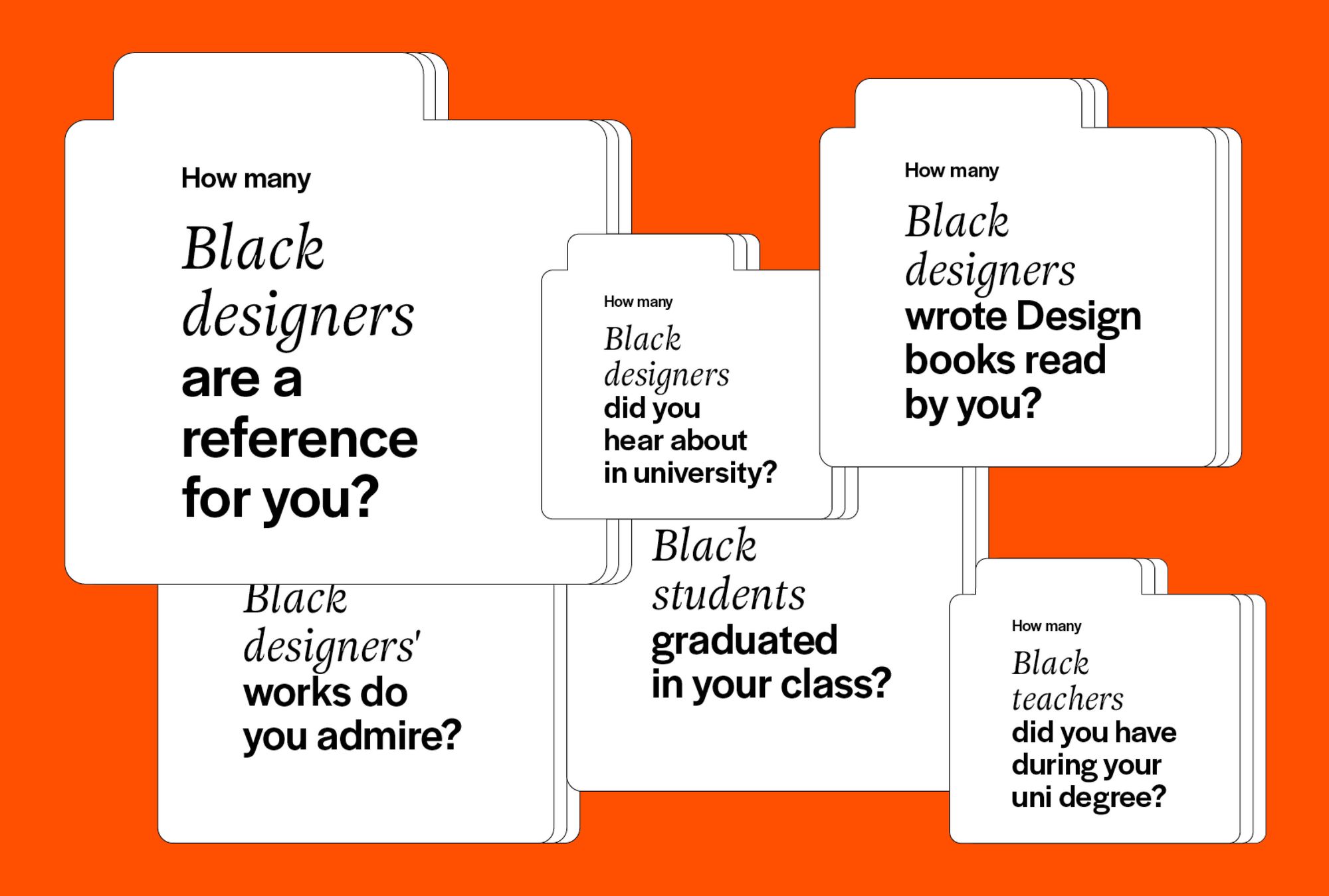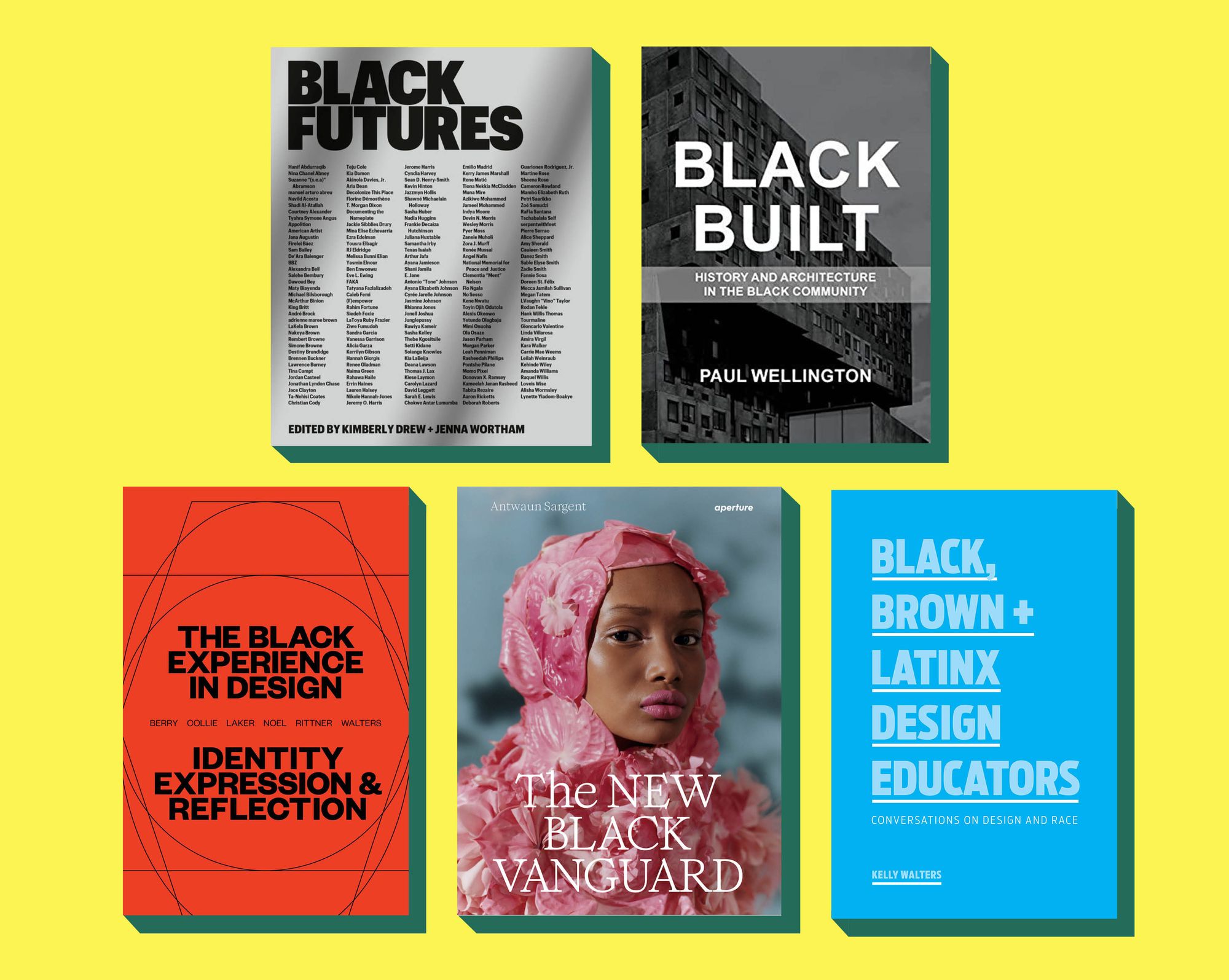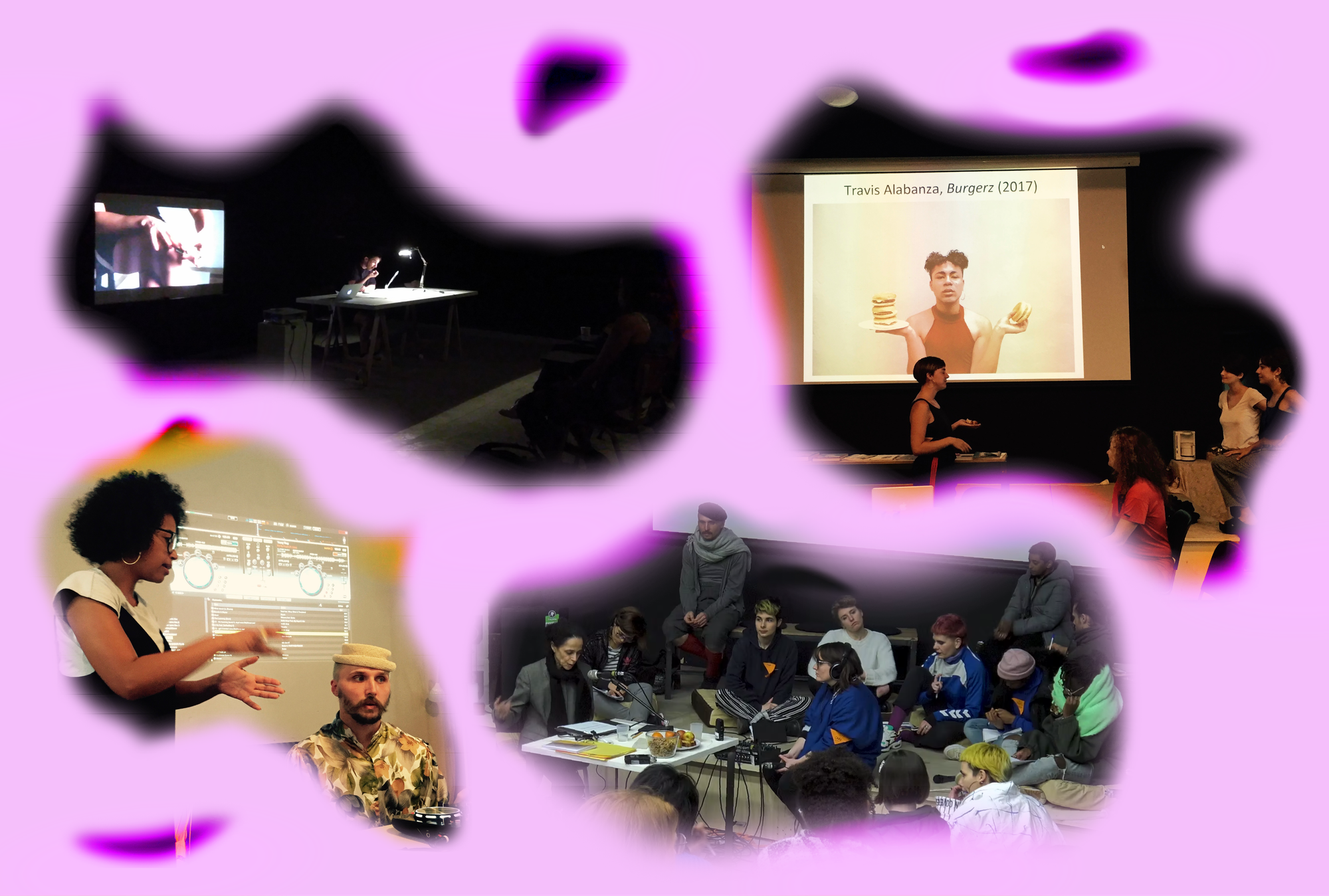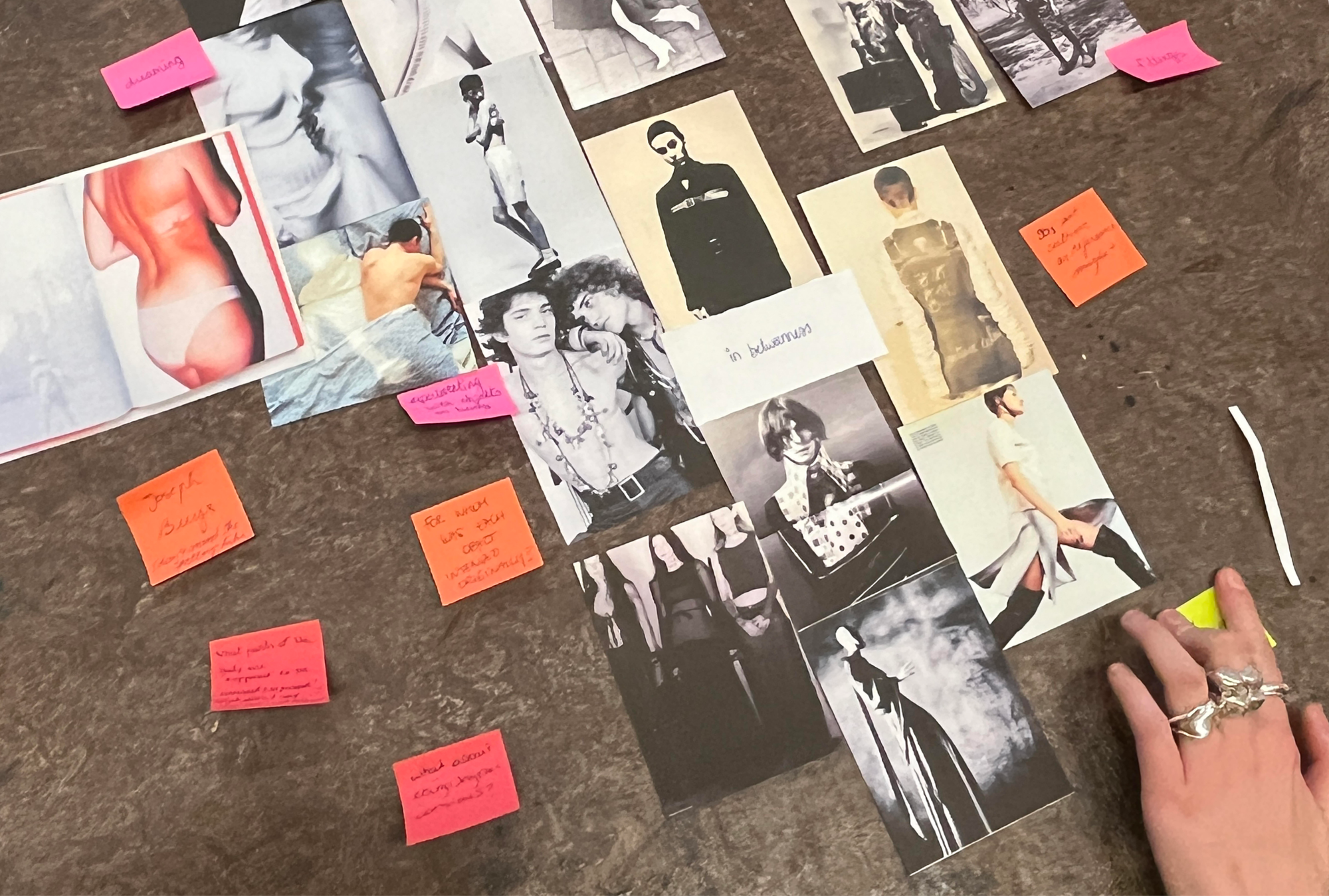
Is it fair to judge a book by its cover? No, right? But what if I said that sometimes, it is okay—and even necessary—to do just that?
I had never given much thought to the saying that we should not judge by appearance. But as we all know, people always judge appearances—especially in the design community. Designers contradict this maxim both literally and figuratively—keeping up appearances is what we do best; judging goes with the territory. And if there’s one thing we like to judge, it’s book covers.
One day in 2020, a black and white book cover appeared on my Instagram feed, and I felt compelled to judge it. I was still new to the U.K., where I’d moved to shortly before the pandemic. I had spent the last several months unemployed, struggling, watching white design colleagues get ahead despite the crisis. In the wake of George Floyd’s murder, the world witnessed a global uprising against white supremacy, but the design corner seemed to be putting up a façade yet again. Floods of black squares inundated my feed, and every design studio, school, museum, or publisher was issuing empty statements and “committing to do better.” Even in my home country of Brazil—a majority Black country where Black activists have for decades denounced the ongoing Black genocide—white designers were now voicing pledges of anti-racism. The insincerity of it all was too much to bear. I felt exhausted. Numbed. Then one day, my phone suddenly alerted me of a new anthology on graphic design education concerned with its “past, present and possible futures.” I didn’t have to read a single page to pass my judgment: of the 42 authors listed on the book’s back cover, not a single one identifies as Black. When I publicly questioned the publisher on Instagram about this absence, they simply responded to my comment indicating for me to read the chapter by a Filipino designer (as if all designers of color were the same) and later deleted the comments altogether. Once again, design was keeping up appearances. I was flabbergasted. In this day and age, how could anyone even think about discussing “possible futures” without including the perspectives of Black designers?
B is for Books, and also Bias
In 2012, I was accepted at the Escola Superior de Desenho Industrial (ESDI), a small and elitist design school affiliated with the State University of Rio de Janeiro (UERJ). Like other Black and low-income high school students, I barely knew what design was before entering college. ESDI’s reputation as the first design program in the country didn’t influence my choice, and neither did its rationalist-functionalist modernist approach, ideologically tied to the Bauhaus and the HfG-Ulm. What really hooked me was the school’s silkscreen workshop and, with it, the possibility of printing my own t-shirts, which until then I had been painstakingly painting by hand.
Higher education in Brazil has historically been a privilege of the elite. Although my parents didn’t finish elementary school, they’ve always championed education as a way out of poverty. I am part of my family’s first generation to access university, and the second of four siblings to enter college—thanks to an affirmative action policy pioneered by UERJ, the first public university in Brazil to implement quotas for low-income, public school-educated, self-declared Black, brown, and indigenous students. Since its inception in 2003, the system, which is still far from perfect, has been expanded to all public universities in the country, which have historically also been entirely tuition-free.

By the time I joined ESDI, the school had already experienced nine years of affirmative action, yet it was still riddled with inequality. In the six years I spent there, except for one teaching assistant and one temporary teacher who later resigned, I had no Black or POC educators. Like most spaces in the highly unequal and unjust city of Rio de Janeiro, the school wasn’t built for historically marginalized people like me. Everything about it instantly made me feel “othered.” Study materials cost a fortune, teachers constantly recommended foreign-language books and cited foreign designers, and students were expected to have been on “cultural” trips to Europe and the U.S.A. before starting their studies. All of it made my day-to-day at ESDI an eternal state of despair. I needed to compensate for lost ground. With few resources, I resorted to what was most accessible to me: books.
Design books are comparatively very expensive. I was only able to buy my first volume—Design as Art by the Italian artist and designer Bruno Munari—when I was in my fourth year at ESDI, living off of an intern’s salary supplemented by the modest monthly scholarship funds granted by law to all “quota” students. Most of what I earned went to pay for the 50 km daily train commute from my parents’ house in Queimados to the school in the city center of Rio de Janeiro. Consequently, I became a frequent resident of the school library, which—despite an onslaught of frequent robberies and termite infestations—remains a stalwart monument in the country. I quickly befriended its librarians, who often found me sitting on the floor between one of the narrow aisles, reading about some famous designer like Munari—in English, of course.
Libraries say a lot about how institutions think. In ESDI’s case, the library housed a profusion of Swiss, German, and European books. Although relevant to my training, the books were an extension of ideas applied in the classroom. Most books suggested by teachers were in English. Mastering the language quickly became a necessity, especially because I was eager to join the (now-defunct) “Science Without Borders” program, a federal grant implemented during the first mandate of former president Dilma Rousseff to finance low-income BIPOC students on an undergraduate exchange abroad. Although I was unfortunately never able to benefit from the program—it was abruptly terminated in 2016 in the wake of Rousseff’s coup—by the time I reached my fourth year, I had become an avid reader of foreign design books. Design from the Global North became what I understood as “good design.”
“In hindsight, I recognize that this outside-looking mentality was a product [...] of the entire design profession, which felt highly alien from Brazilian reality.”
At that point, I started expanding my own library, buying second-hand monographs online and in the many used books stores in the city center of Rio de Janeiro. I especially sought books by Swiss designers, in particular those published by Arthur Niggli and ABC Verlag in the 1960s and 1970s. As my bookshelf with Swiss-style spines grew, I started to speculate if my professional life would be more successful abroad. In hindsight, I recognize that this outside-looking mentality was a product not only of my education at ESDI but of the entire design profession, which felt highly alien from Brazilian reality. This disconnect was described by design writer and historian João de Souza Leite in his 2007 text With its back to Brazil: teaching an internationalist design.
For a long time, I felt grateful for the possibility of even having a degree, since many like me didn’t even come close to achieving one. Slowly, however, I began to come to terms with my alienation. To understand how design functions as a tool for maintaining power and privilege, one must examine how the intersecting exclusions of race, class, gender, and other determinants operate. At ESDI, several of my wealthy white classmates already knew each other before university as they had studied together or were part of the same cultural elite clique. They had access to English and German courses, which enhanced their CVs, and they also lived much closer to their workplace, so they received better opportunities. I, on the other hand, was a queer Black designer from the outskirts. I was unwelcome; there was no place for me. I was continuously verbally and morally abused every day at ESDI, and I soon found myself spiraling into despair. Eventually, instead of continuing to the fifth graduating year, I decided to take a break from school.
“Suddenly, collecting “good design” volumes by American and European designers felt absurd. I couldn’t relate to these books in any way anymore. Instead of building myself as a designer, these books were breaking me apart as a person.”
I started an internship at the Centro Municipal Hélio Oiticica, an art center located near to ESDI. There, I met Daniele Machado, a curator, art historian, and educator researching issues around memory, trauma, and health within Brazilian and Latin American art. I got closer to a world of art practices dealing with social and racial struggles, and met people from diverse backgrounds with whom I shared real-life issues. I wasn’t in the design realm anymore, and it felt good—really good. Eventually, I started to question the voices—or silences—behind my small library of books. Suddenly, collecting “good design” volumes by American and European designers felt absurd. I couldn’t relate to these books in any way anymore. Instead of building myself as a designer, these books were breaking me apart as a person. Shattered and deconstructed, I had to look for new pieces of “me.”
Judging by the cover
Going back to the pandemic month of November 2020, that publisher’s bizarre answer to my question about the absence of Black authors kept resonating in my head. How could I, as a designer, respond? Making a purely visual statement wasn’t enough; what was needed was a tool to make the problem visible. This is what prompted Judging by the Cover, a platform dedicated to exposing racial inequality and anti-Blackness in design publishing, which I launched in early 2021. Despite the title, I don’t judge a book’s cover design. Instead, I analyze the race and ethnicity of its authors, understood as the writers, editors, and collaborators whose names appear on covers, back covers, and spines. To gather data, I surveyed the online design catalogs of ten international design publishers between October and November 2020. My conclusion is frightening yet unsurprising: design publishing is overwhelmingly cis-gendered, male, and white.
At the time of the project’s launch, the Swiss publisher Niggli Verlag had not a single title by a Black or a person of color: all of its 99 books were penned by white authors. The German Taschen also had zero design books by Black authors, and only a handful of books by people of color in its 68 titles. The U.K. publisher Thames & Hudson also didn’t perform well: of the 282 books in its design catalog, 250 were exclusively by white authors, 24 included authors of other ethnicities, and only eight had Black authors. Of the 108 design books listed by the Swiss publisher Lars Müller, only one featured a Black author: the Burkunabese architect Francis Kéré, who is one of eight contributors in a monograph about a Swiss architecture studio. If my calculation were proportional to the total number of authors, overall results would likely reveal an even greater disparity. But in the end, these numbers don’t lie: they expose the blatant lack of representation in design publishing.

Judging by the Cover highlights the names of the few Black authors who made it into design publishing. Although the final data visualization emphasizes the exclusion of Black people, if someone were interested in knowing, for example, the percentages of Asian people in design publishing, they can also filter this information through my free online database. Fact-checking was done through websites and social networks such as Linkedin, Instagram, Facebook, Twitter, and Forebears. When in doubt, I reached out to the authors directly, explaining the project and asking the person to self-identify. Since it would be very difficult to contact every single author in my data pool, I came to terms with having an imperfect data set and made this margin or error transparent. Although I couldn’t break the numbers by gender for this first iteration of the platform, my initial perception is that Black women, unsurprisingly, feature at the bottom edge of the publishing field.
I opted for the website format to make the information available and accessible to as many people as possible. I was inspired by projects like Eu, Cotista (Me, a quota student), a 2018 survey on quota students at UERJ by José Andres, as well as W.E.B. Du Bois’ series of diagrams on the advances of the Black population in the U.S.A., originally presented in 1900 at the Exposition Universelle in Paris—the same event that had previously showcased Black people in a human zoo. My visual diagrams are direct and easy to read, complemented by the only two typefaces by Black type designers found on Adobe Fonts: Adriane Text by Marconi Lima and Halyard Display by Joshua Darden.
Initially, I was conflicted about publishing my survey in English instead of my mother tongue, Portuguese. I think it’s extremely important to produce critical content in Portuguese, accessible to students and designers who don’t speak other languages, precisely because I was once in that position. But since I’m now living in the U.K., I also wanted the project to reach my immediate context, which is why I was thrilled it sparked interviews with It’s Nice That, Creative Review, and an invite to participate in an event on Data and Design at the Victoria & Albert Museum. The project also connected me to many creative, critical, generous people and platforms, including Deem Journal, Sound x Advice, Where are the Black Designers?, BIPOC Design History, Futuress, Revista Recorte, and many others.
Judging the Cover in Context
A couple of months after launching Judging by the Cover, I met a Canadian designer and friend. As we discussed books and compared our different academic experiences and traumas, I realized the disparity in our education. While his references were largely from the U.S.A., mine were mostly European. Yet, we had so much in common: we are two queer immigrants of color, and we’d each been on a journey to unlearn the hegemonic design imposed on us, striving to bring our profession closer to our lived experiences.
In the six years I spent at ESDI, I became a designer, but I also came to terms with my Black identity. Today, almost two decades after the quota system was first introduced, the teaching staff at the school is still overwhelmingly white and upper class. The environment is still unnecessarily competitive, plagued with flagrant racism, sexism, classism, homophobia, and aporophobia—the hostility towards impoverished people. Lack of accountability pushes marginalized students to the edge: there are still no complaint mechanisms for reporting abuse, harassment, and discrimination. When students do speak up, nothing happens that leads to real tangible structural change.

Despite that, quota students have become increasingly more vocal in the last few years. Precisely because we arrive at the university alone and without support, over time we learn to articulate ourselves in informal support groups after class or through social media. Looking at the recent batch of graduation projects, one realizes that, compared to white upper-class students, quota students tend to be more critical of design’s entanglement with systems of oppression, addressing topics such as discriminating algorithms, barriers to urban mobility, the quota system itself, and so on. This pattern also appears to continue professionally, with designers from marginalized groups starting their own projects and platforms to fight inequality and discrimination. Some examples are Wagner Silva’s now viralized article on Black design references, the national online directory of Black designers, Designers Negres no Brasil, the platform for Black women in tech PretaLab, and the Black creative consultancy Ubunttu, among many others.
In Brazil, being a design educator or even having the slightest interest in design education is still a privilege of the elite. After graduation, designers from marginalized backgrounds tend to bet on professional paths with better financial prospects. In the current Brazilian scenario of high inflation and unemployment, this tendency is even more visible. For Black and low-income graduates, pursuing a teaching career is a sacrifice they are unwilling to make. In addition to low salaries, there is the mental and emotional fatigue of dealing with environments that are emotionally and morally abusive. In the end, hegemonic spaces are bound to attract the usual suspects.
Since the beginning of the COVID-19 pandemic, however, there has been some positive change. Specifically, within design publishing, we’ve seen a series of Black-centered books, including Black Futures, Black Built, The Black Experience in Design, The New Black Vanguard, Black, Brown + Latinx Design Educators, and the forthcoming Black Design in America, to name just a few. We can only hope that these titles will empower more Black educators to teach design, more Black designers to open their own studios, and consequently more publications by Black authors, continuing the circle into the future.

At the same time, there has also been a heightened interest in design anthologies, books claiming to represent a plurality of voices. We must, however, remain critical of the supposed “diversity” that some of these books portray, oftentimes through tactics of “inclusion,” through which non-hegemonic perspectives remain a minority within a white majority, in a process akin to ticking boxes. Another recurring problem is the extractive approach through which many white editors use their privilege to publish design books on marginalized groups, oftentimes through a wrongful exoticizing lens. Sadly, those in privileged positions have greater freedom to steer their power and privilege in ways that benefit their careers, especially in academia. To all white designers, authors, educators, and editors out there: instead of acting as gatekeepers, why not simply pass the mic?
“We must [...] remain critical of the supposed ‘diversity’ that some of these books portray, oftentimes through tactics of ‘inclusion,’ through which non-hegemonic perspectives remain a minority within a white majority, in a process akin to ticking boxes.”
Lately, I find myself wondering what would have happened if more reparations for slavery and systemic racism, such as the quotas system I experienced, had been implemented since the foundation of universities across Brazil and beyond. What teachers would we see in leading classrooms today? What kind of references would we have? Whom would the design serve? Although counterfactual thinking might seem pointless, it is an essential exercise for imagining possible, better, more just futures. So that we can keep thinking together, I want to reinforce the invitation I made at the very beginning of this text: are you ready to take a look at your own bookshelf, and judge your books by their cover?
A first version of this text was published in Portuguese with Revista Recorte in March 2022. The Brazilian platform’s mission aims at diversifying the design discourse and is meant as a space for designers to voice their frustrations, small obsessions, their points of view, and proposals for the future. Publishing this edited version of the text on Futuress inaugurates a new collaboration with the platform.
Leonardo de Vasconcelos Santana (he/him) was born and raised in Queimados, Rio de Janeiro. He holds a bachelor’s in Industrial Design from Escola Superior de Desenho Industrial-Esdi through the quota system from Rio de Janeiro State University. He is the creator of Judging by the Cover, a project highlighting race bias in design book publishing through data visualization, earned with interviews for design blogs, and participation in an event called Data and Design: Making Stories Visible, produced by the V&A Museum. Currently, Leonardo is divided between his livelihood as a designer working with cultural institutions and a researcher in his (few) spare time. His discussed topics almost always come from his perspective as a person of poor & black & immigrant background and the many possible relationships with and beyond design.
Title image: Leonardo de Vasconcelos Santana.
The title of this vertical, Epistemic Activism, is an homage to the disabled, nonbinary Iranian/SWANA designer and researcher Aimi Hamraie. In their book Building Access: Universal Design and the Politics of Disability, epistemic activism is described as a form of
political action that occurs within academic fields to shape social norms and practices.















